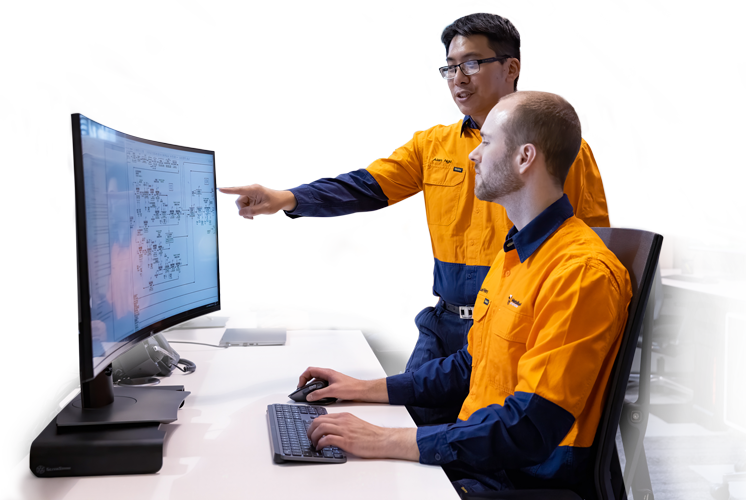Enabled accurate sustainability reporting pinpointing significant losses in revenue

To meet sustainability reporting standards set by the International Sustainability Standards Board, mining and minerals operations need to accurately track Scope 1, 2 and 3 emissions, water and energy consumption – at granular level. Here’s how Metallurgical Intelligence®, a process digital twin, can give mining and minerals professionals the tools and data-led insights to meet Scope 1, Scope 2, and Scope 3 reporting requirements.
Challenges
Without the right digital tools, many mining and minerals facilities struggle to accurately report their emissions, water and energy consumption to the level required by the International Sustainability Standards Board.
In this case study, we have three worked examples by Scope 1, Scope 2, and Scope 3, for various operations that lacked ready access to the data they needed, as well as the ability to analyse exactly where emissions weren’t optimised and to make proactive changes.
SCOPE 1: For this smelter plant, being able to accurately report on its Scope 1 emissions was difficult – using gas analysers that were not operating properly and estimated metrics that leads to overreporting of emissions.
SCOPE 2: Often, Scope 2 emissions are calculated through the use of billed consumption from grid electricity and other utilities. However, this may be a poor estimate of consumption and hence Scope 2 emissions.
SCOPE 3: The key to understanding and lowering Scope 3 emissions requires a detailed breakdown of the different components by contribution. This is often difficult, as accessing a wide range of plant and business data and formulating it into a single report that updates regularly is not always simple.
Solution
Metallurgical Intelligence® was implemented at these sites, which obtained data from all aspects of the operations to be incorporated within a process digital twin dynamic model.
Data from the digital twin model was then extracted and used in customised reports to better understand all aspects of plant operations, including emissions, water, and energy consumption.
SCOPE 1: Using Metallurgical Intelligence®, it was quickly identified that the gas analysers were not working correctly, and that there was a large discrepancy between the daily acid production mass according to the historical daily balance versus the mass produced according to the Metallurgical Intelligence® digital twin solver model. Additionally, rather than using estimated metrics to determine other GHG emissions, the actual amount can be calculated and validated using the digital twin.
SCOPE 2: Metallurgical Intelligence® was implemented at the site, which obtained data from all aspects of the plant to be incorporated within a digital twin dynamic model. Data from the digital twin model was then extracted and used in customised reports to better understand all aspects of plant operations, including energy consumption. This included monitoring power costs per area per day, which could be compared against billed information.
SCOPE 3: Using Metallurgical Intelligence®, all scopes of carbon emissions, including Scope 3, can be reported on easily, with results automatically produced daily for distribution and analysis.
Results
By implementing Metallurgical Intelligence®, these mining and minerals operations now have the ability to completely transform their sustainability accounting and emissions, water and energy consumption reporting across all three scope levels.
SCOPE 1: Using the digital twin, it was discovered this site was underreporting Scope 1 greenhouse gas emissions through unrecorded SO2 gas losses. Over this time, an additional 350 tonnes per day of potential sulphuric acid production was lost, or US$58,000 per day (US$21m per year)
Through the use of Metallurgical Intelligence®, a combination of both measured data alongside a digital twin dynamic model can be used to provide the most accurate Scope 1 emission values that do not overrepresent the mass of other GHG emissions released.
SCOPE 2: The digital twin was able to incorporate all plant instrumentation and power data in order to provide accurate cost estimates and total required power draw, used in regular automated daily reporting.
It was found that on average, 42 MWh of excess electricity was purchased per day, equivalent to US$1.5m per year. The power was being generated, and billed, but not used for production. The new energy consumption metrics can now optimise energy consumption and improve Scope 2 emissions per unit of production. This enables the site, to reduce the Scope 2 CO2 emissions per unit of production by 7.5%. Which equates to 8,000 t-CO2/year.
SCOPE 3: Through the use of Metallurgical Intelligence®, detailed breakdowns of Scope 3 carbon emissions can be calculated, and breakdowns can be formulated. For example, sites can compare reagent consumption and calculate their impact on overall Scope 3 emissions.
